Take a Brazilian Food Safari and learn about many popular ingredients and foods including feijoada:
Take a Brazilian Food Safari and learn about many popular ingredients and foods including feijoada:
Honeybees fight cavities?
Brazilian honeybees make a sticky substance called propolis to patch up their hives. This mixture of beeswax and local tree secretions has the potential to reduce cavities in humans up to 60%.
A sweet invention…
The sweet, seedless navel orange was first recorded in the mid-1800’s on a sour orange tree in a Brazilian monastery (according to National Geographic). This happy accident was then developed and bred into the sweet navel orange we enjoy today. The “navel” on the orange is actually a second, underdeveloped orange (pictured bottom right).
World-class diversity
Brazil claims the greatest diversity of primates, amphibians and plants in the world. Additionally, Brazil is in the top five in the world for birds and reptile species. Incredible biodiversity of plants means great things for the juice and wine world. Road side juice bars are bursting with all sorts of fresh squeezed tropical fruit such as pineapple, guava, soursop, papaya, passionfruit, mango, and cupuaçu. In the south, wine is the “next big thing.” According to the New York Times, 300 days of sun per year means that Brazilian vinyards have multiple harvests throughout the year!
Sinatra’s take on coffee
As Sinatra sings “They’ve got an awful lot of coffee in Brazil […] Why they could percolate the ocean in Brazil.” (Coffee Song, 1946)
http://www.youtube.com/watch?v=YixwrxRzCd4
httpv://www.youtube.com/watch?v=YixwrxRzCd4
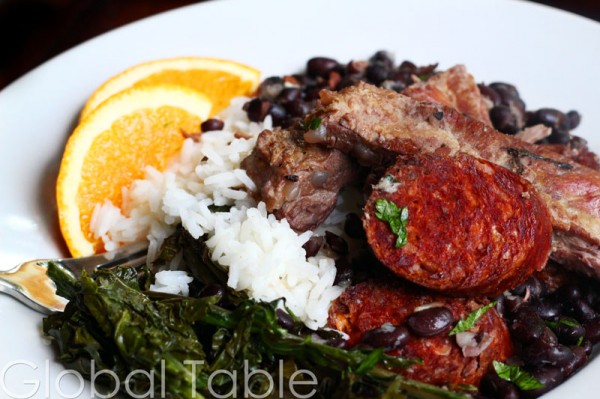
Feijoada is Brazil’s stew of choice for lazy Saturdays and potluck Sundays. At it’s absolute best, Feijoada is a massive pool of black beans piled high with a glorious assortment of meat. One plateful will provide enough slow-burning energy for a marathon, although you won’t be able to run after eating it! This is definitely a meal for elastic pants.
Originally, Feijoada was made with pig ears, tails, and feet. Today, this hearty dish is typically made with dried beef (carne seca) and pork meats – usually sausages, like paio, and ribs. According to my Brazilian classmate from high school, “cow tongue is also super popular (and yummy).” Like chili in the USA or Beef Bourguignon in France, there are as many recipes as there are mammas (and papas) cooking.
Serve Feijoada with farofa (manioc flour pan-toasted in butter), sweet orange slices, and white rice. Sauteed kale is a popular side dish too. Although this green is bitter, you’ll be glad you made it because feijoada sends diners begging for veggies to balance out the beans and meat.
Although I was unable to obtain all of the proper ingredients, I gave it my Girl Scout best and believe this version to be a tasty approximation. I just wish I could travel to Brazil to try the real thing 🙂
Serves 6
Ingredients:
1 rack pork ribs (about 2 lbs)
2 paio sausage (I had to use cured chorizo sausage- 1 large)
1 pork shank bone, smoked (about 1 lb)
Some carne seca, if you can find it.
Oil
Salt
Pepper
1 lb dried black beans, soaked according to package instructions
2 slices bacon, chopped
1 large onion, chopped
5 garlic cloves, halved
water to cover beans
Method
1. Preheat oven to 450F. Place ribs, sausage, and shank bone on a baking sheet. Rub with oil, salt, and pepper. Roast in oven until browned, about 40 minutes. Cut up meat (make coins with sausages and separate out each rib)

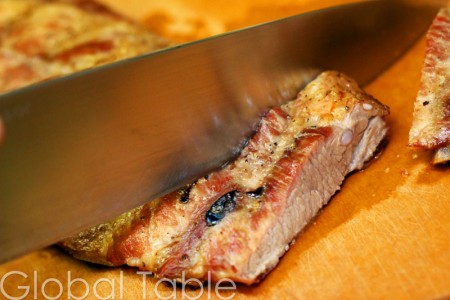

2. Add bacon to a large pot and brown over medium heat. Add onion and garlic. Cook until fragrant and soft.

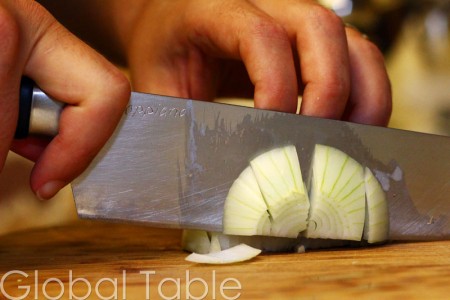
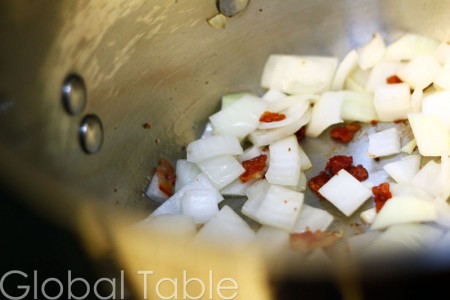
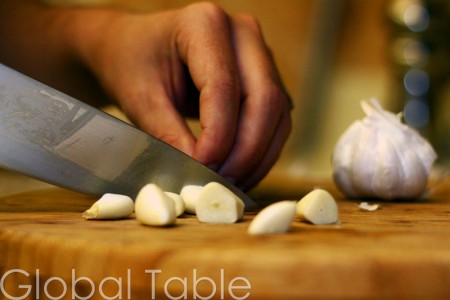
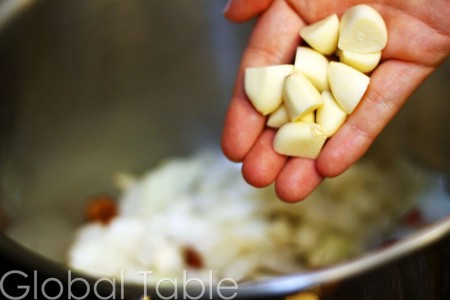
3. Add meat to pot. Add beans.
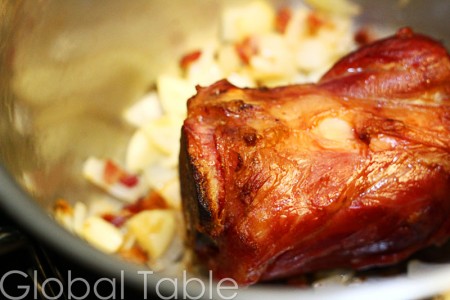
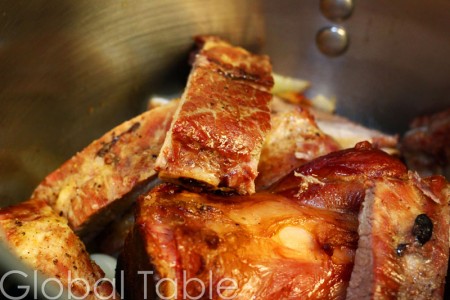
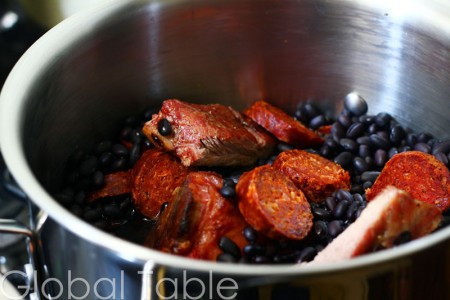
Add enough water to cover the beans (but not necessarily the meat – I did this and it was way too much water. You can always add more if you need to)
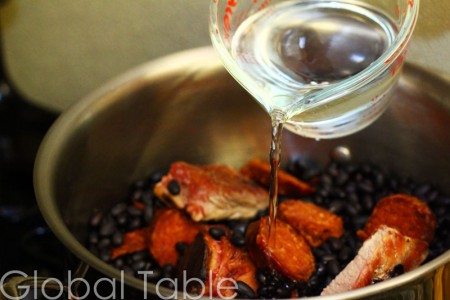
4. Simmer about 2 hours, or until all ingredients are cooked and soft. Skim the yucky fat and froth every once in a while.
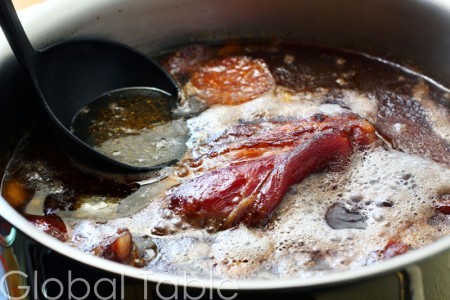
Serve immediately (although I found this to be better the next day)
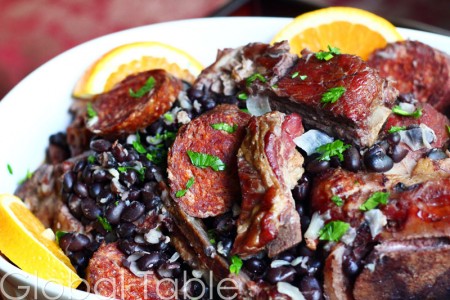
| Servings | Prep Time |
| 6 people | 10 minutes |
| Cook Time |
| 3 hours |
|
|
|
Originally, Feijoada was made with pig ears, tails, and feet. Today, this hearty dish is typically made with dried beef (carne seca) and pork meats – usually sausages, like paio, and ribs. According to my Brazilian classmate from high school, “cow tongue is also super popular (and yummy).” Like chili in the USA or Beef Bourguignon in France, there are as many recipes as there are mammas (and papas) cooking.
Serve Feijoada with farofa (manioc flour pan-toasted in butter), sweet orange slices, and white rice. Sauteed kale is a popular side dish too. Although this green is bitter, you’ll be glad you made it because feijoada sends diners begging for veggies to balance out the beans and meat.
|
If you can't find paio sausage, substitute cured chorizo.
Brazilians are a beautiful, proud, and fun-loving people who would rather have sand beneath their feet than snow any day of the week. Our first two Global Table dishes capture the spirit of Brazil – wholesome and strong. The second two dishes reflect the heart of Brazil – sweet and smooth. Make one of these dishes, shut your eyes, and pretend you’re in the Brazilian sunshine!

Black Beans with Assorted Meats (feijoada completa) [Recipe]
Black beans simmered slowly with tender ribs, tangy chorizo, and smoked pork shank. Variations on feijoada abound and, in this recipe, we make several suggestions for authentic versions.
Sauteed Red Kale [Recipe]
Bitter kale cooked in a little olive oil, with a splash of vinegar.
Brazilian Iced Mocha-Cola [Recipe]
Cool down with a jolt of chocolate milk, double-strength coffee, and cola.
Romeo and Juliet (Romeu e Julieta) [Recipe]
Slices of sweet guava paste layered with soft, creamy white cheese – hauntingly romantic.
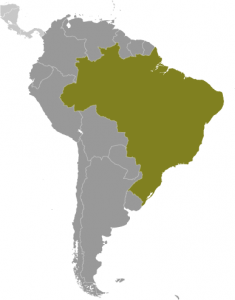
Photo courtesy of the CIA World Factbook
From the towering rain forest, to the coastal plains, we could spend a lifetime sampling food in Brazil. Almost as big as the U.S.A, to say that Brazil brings a lot to our Global Table is quite the understatement.
I’m willing to bet you’ve had some of the local specialties.
Take Brazil nuts, for example. These giants are always the biggest nut in a tin of mixed nuts. Grown wild, high in the canopies of the Amazon, locals stir them into all manner of tasty cakes and sinful confections. Until about five years ago I always avoided the Brazil nut. The flavor seemed so unusual – so earthy – and the texture could be… squeaky. It’s true. But, through the years, I’ve made friends with the Brazil nut (as I have with other strange tasting items, like blue cheese and brie). Give ’em a try!
Coffee is another local specialty. Brazil produces more coffee than any other country in the world. If you’ve ever used coffee to lift the cottony fog of sleep from your brain, you’ve probably had Brazilian coffee. For the most part Brazilians grow Arabica, a slightly less caffeinated bean.
Brazil’s unique melting pot reflects a varied history with European (mainly Portuguese), African, and Ameri-Indian influences. To the north you’ll recognize many Carribean and African favorites like coconut, sugarcane, beans and rice, and red palm oil, as well as indigenous specialties . To the south, ingredients become increasingly European as illustrated by their use of pasta. However, there is no distinct border and, like any melting pot, many foods are found in both regions.
The most talked-about dish in Brazil is feijoada completa, or black beans with assorted meats. This dish emerged from the creativity of slaves who had to make due with what little scraps of meat they were alloted (like ears, tails, feet). Today, this flavorful, one-pot dish is considered by many to be the national dish of Brazil and there are as many versions of feijoada completa as there are mammas making it!
Manioc flour, made from cassava (also known as yucca), is another Brazilian staple. Toasted in a little butter until golden brown, this crunchy farofa can be used to top many dishes, including feijoada completa.
But, wait, let’s go back to the topic of meat.
Oh, they sure know how to eat meat in Brazil. Link upon link of smoked, dried, and fresh sausage, leathery sun-dried jerky (called charque), anything pork, and all things chicken… incredible. Churrasco, Brazilian barbecue, takes on gargantuan proportions, as huge slabs of meat are served on sword-like skewers. For a delightful change in pace, fish reigns supreme on the seashore and along the endless bends of the Amazon. Locals even eat the sensationalized piranha, whose head is considered an aphrodisiac.
The list of produce is distinctly South American: bitter kale balanced by sweet yam, even sweeter corn, and sweetest sweet potato … Brazilians also enjoy hot peppers, cassava, beans, sugarcane, cocoa, citrus, rice, and wheat.
And now, for the grand finale … dessert. As I read through the giant list of desserts, one lured me in with it’s beautiful, heartbreaking name – Romeu e Julieta (Romeo and Juliet). What a mystery of seduction and intrigue it must be – slices of sweet guava paste layered with soft, creamy white cheese. If that’s not just the most wonderful concept in the history of simple desserts… Brazilians have also mastered the baked custard. Baked custard is a favorite in Brazil, with flavors ranging from plain, to tropical coconut, citrus orange, and sweet potato.
Yummy. I wish I could cover it all.

With a few simple steps, our Botswana Global Table Adventure transformed minimal ingredients into a tasty feast. Although I struggled to get Keith to eat the spinach (spoiler: I won), the general consensus was that this was a great meal, worthy of any weeknight menu.
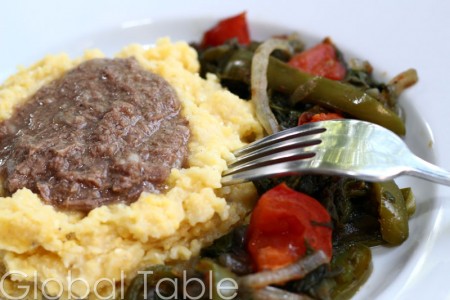
Stewed Beef (Seswaa) [Recipe]

What I liked most about this dish:
I made Seswaa with a beautiful, fatty piece of chuck. As the marbling broke down, the stew’s flavor grew deeper and richer. I was amazed at how much meaty deliciousness came through this simple dish. I found myself smacking my lips and wanting more. Looking around, seemed like the family was in agreement. Since making Seswaa, I’ve been dreaming of ladling the meaty gravy over freshly baked biscuits. Oh man, that would be good.
What I liked least about this dish:
I know Seswaa isn’t much to look at, but the stew is just so tasty. Since there are few ingredients, Seswaa’s flavor depends on the cut of meat you get. Ideally, choose a fresh piece of well-marbled meat. Think of those flowing white lines as rivers of flavor! Just be sure to skim the top of the meat every twenty minutes or so, to reduce the “greasiness.”
Also, while I used an immersion blender to quickly break apart some of this meat, you can also mash it with a mallet or by hand (a more traditional way to go). An immersion blender breaks up this meat into tiny pieces, really quickly. While the flavor is still wonderful, you might prefer to hold back a little power to make a chunkier blend.
Stewed Spinach Greens [Recipe]
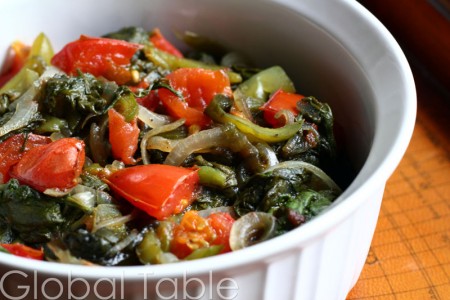
What I liked most about this dish:
As the baby spinach, onion, pepper, and tomato wilt down, their juices release and mingle. The result hits a spinach lover’s sweet spot – slightly bitter greens sweetened by softened onion and pepper, and brightened by a shot of mildly acidic tomato. With minimal fussing required, this is a perfect week-night vegetarian side dish. We’ll definitely be making these greens again, much to Keith’s disappointment (see below).
What I liked least about this dish:
While I enjoyed these Stewed Spinach Greens, my husband put up a big, fat, pathetic fight. I had to pull the “our baby is watching you” card. I had no other recourse. He just kept muttering “slimy” and “bitter” over and over again, while whimpering. He’s obviously not a spinach lover… Ava watched the entire show he put on while munching away on her spinach. The look on her face was something between “Papa, what’s the big deal?” and “I love you!” She’s such a sweet girl. The peer pressure broke him down and he ate his whole serving. We’re very proud.
Cornmeal Pap [Recipe]
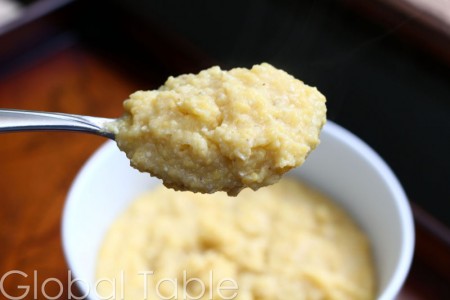
What I liked most about this dish:
Cornmeal Pap is a fun way to break up the uninspired routine of rice, pasta, or potato that usually goes on in our house. Pap is filling and comforting, if a little plain. Really more of the supporting element of your meal, most of the flavor will come from whatever stew you put with the cornmeal mixture.
What I liked least about this dish:
I knew this dish would be plain, so that did not bother me very much. However, I did not realize the softened porridge texture would quickly set up into a firm, almost sliceable polenta… In the 30 minutes we spent snapping our photos for the blog, things were getting rather stiff in the pap bowl. Just be sure to serve the dish hot from the pot and you’ll be fine.
Rooibos Tea
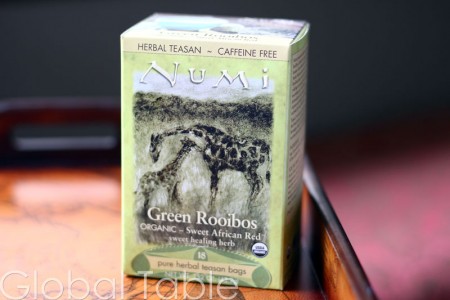
About this drink:
Another delicious decaffeinated tea to add to my arsenal (nursing Ava means I try to drink as little caffeine as possible). There are two kinds of Rooibos – green and red. I tried the green and enjoyed the slightly smoky, grassy undertones. The drink begs for a little lemon and honey (this is the traditional way to drink it). I also tried it with milk (I have a tough time not putting milk in my tea or coffee) and found this to be fine too.
Ava’s Corner
Ava’s Botswana review: “It’s all good!”
Don’t ask me how I know… I’m her mamma! 😉
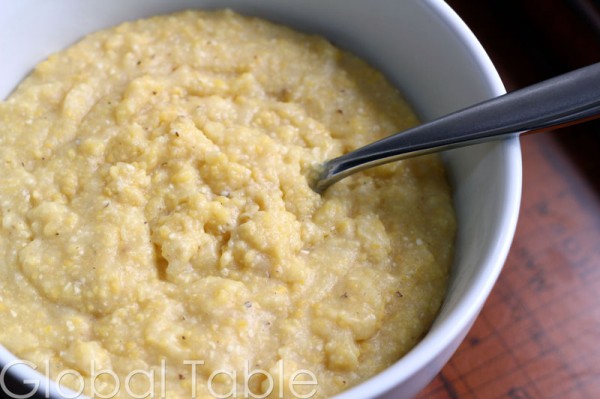
Serves 2-4
In Botswana, Cornmeal Pap is eaten with the fingers, dipped into stews to pick up additional flavor. Like soft polenta, Cornmeal Pap goes well with any stewed meat or vegetable. The mixture stiffens up quickly, however, so serve immediately after cooking.
NOTE: Please use white cornmeal for authentic pap. (I had to substitute yellow)
Ingredients:
1 cup cornmeal (fine or medium grind is best)
1 quart broth (vegetable, chicken, or beef)
salt
pepper
Method:
1. In a medium pot, bring stock to a boil.
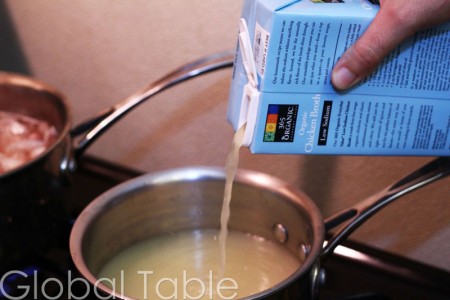
2. Stream in cornmeal slowly. Whisk continually to keep mixture from lumping.
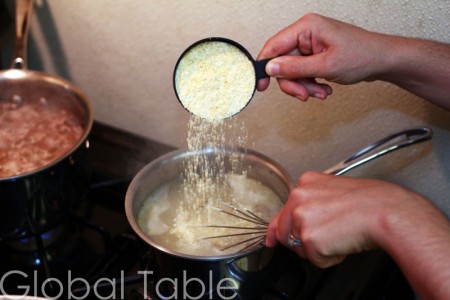
3. As mixture thickens, you may need to switch to a wooden spoon. Allow to simmer gently until cooked to desired consistency, about 20 minutes. Season with salt and pepper. Serve immediately (Pap stiffens up considerably as it cools).
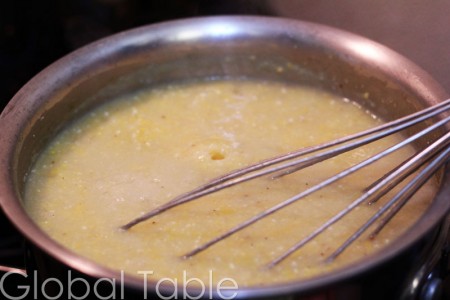

Serve immediately (Pap stiffens up considerably as it cools).
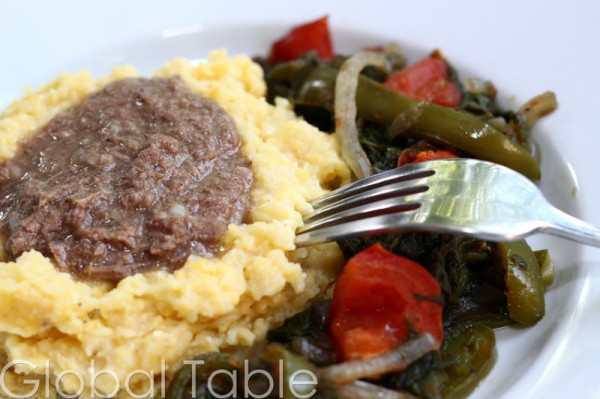
Serves 2-4
Seswaa is traditionally highly salted. In fact, the simplest renditions of this yummy dish are made with nothing more than beef, salt, and water. Our version includes onion and minimal salt, since I was serving it to my daughter. The thickened juices become rich from long, slow simmering. Something between gravy and pulled pork in texture, this dish would be wonderful poured over biscuits.
Ingredients:
1 1/2 lbs beef, cubed (I used chuck)
1 large onion, chopped
water
2-4 Tbsp flour
salt
pepper
Method:
1. Place all ingredients in a medium pot, except flour. The water should just cover the top of the beef. Bring to a simmer and cook uncovered for 2 hours.
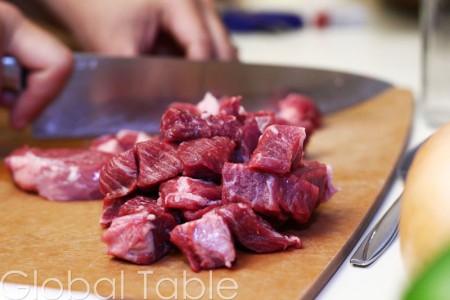
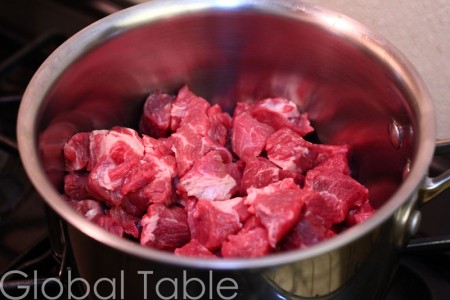
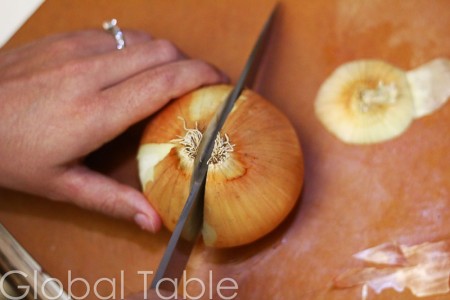
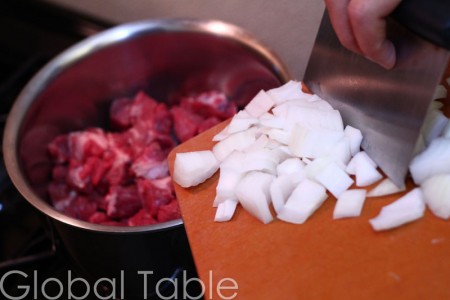
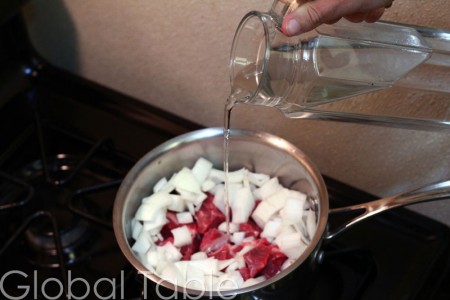
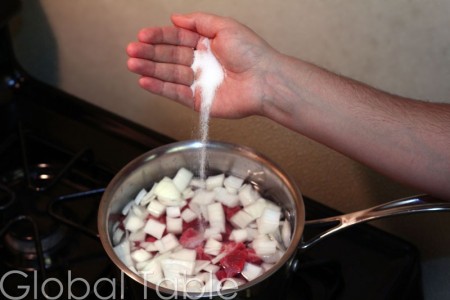
NOTE: Skim the fat every 20 minutes or so for a lighter flavor.

2. Using an immersion blender (or a mallet) break up some of the meat into small pieces.
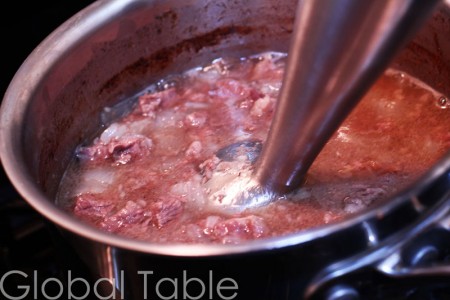
3. Make a flour slurry (mix a little water with flour until it forms a glue-like consistency). Add to stew. Cook a few additional minutes, until the flour thickens up the stew. Serve immediately with cornmeal pap or rice.


Serves 2-4
I love this easy, no-nonsense, super healthy side dish from Botswana. Simply steam spinach in its own juices until all the vegetables are soft. If you’d like to leave the tomatoes a little firmer, add them half way through cooking.
Ingredients:
1 lb baby spinach
1 large onion, sliced thinly
2 tomatoes, chopped
1 green pepper, sliced thinly
oil
salt
pepper
Method:
1. Add all ingredients to a large skillet or wok. Cover and heat over medium-low, stirring occasionally. Cook for about 30 minutes, or until all vegetables are soft. Serve hot.
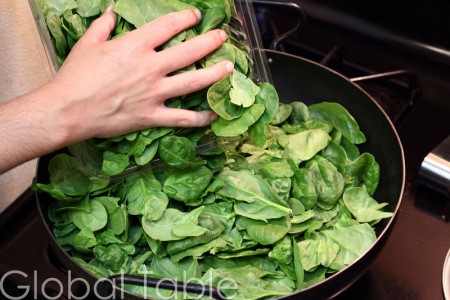
The thinner the onion, the quicker it will cook and become tender. Look how pretty – you can see the knife through the onion! 🙂
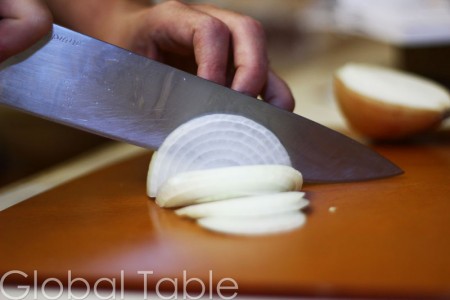
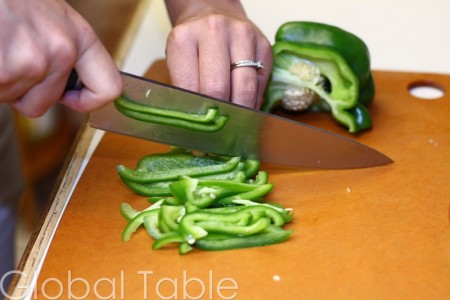
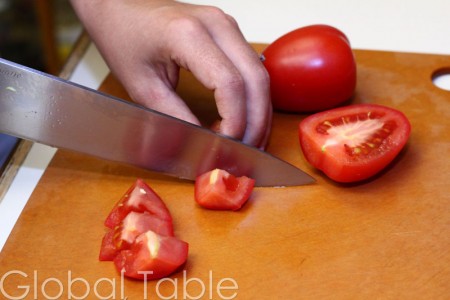 ‘
‘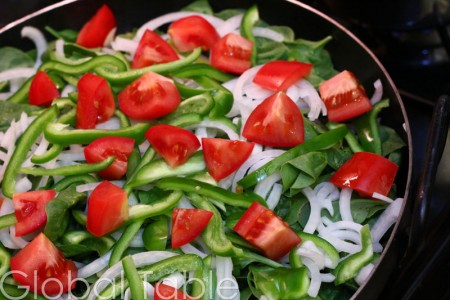
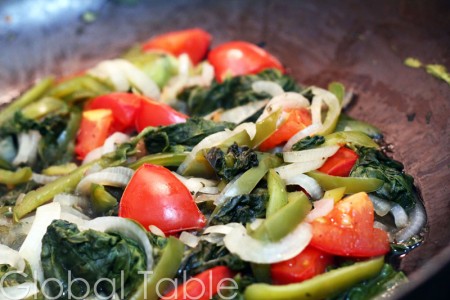
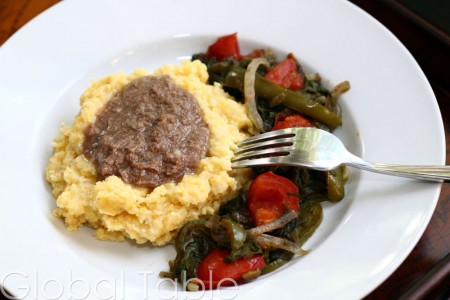
| Servings | Prep Time |
| 2-4 people | 10 minutes |
| Cook Time |
| 30 minutes |
|
|
|
I love this easy, no-nonsense, super healthy side dish from Botswana. Simply steam spinach in its own juices until all the vegetables are soft. If you’d like to leave the tomatoes a little firmer, add them half way through cooking.
|
Today I thought I’d share a PBS clip and then one from the funny British car show, “Top Gear,” in Botswana. There are seven parts to this video out on youtube, and I would highly recommend them, if you enjoy this first segment. They go over the salt flats, through the kalahari, and then the Okavango Delta.
Aren’t Friday’s are just … the best? A day of completion – the week’s end – on the eve of renewal! I hope your Friday is wonderful. For a little entertainment, check out these factoids about Botswana…
On the dry side…
Two thirds of Botswana is covered by the sands of the Kalahari desert. In these parched areas, a variety of wild melon supply water and nutrition to inhabitants. Vegetables are often salted and dried for preservation.

Photo courtesy of the CIA World Factbook
The marama bean, encased in a hard shell and high in protein and oil, is one of the most important sources of nutrition in the Kalahari. When roasted the rich, soft, nutty flavor is a cross between cashew and chestnut.
On the wet side…
Botswana is home to the sprawling Okavango Delta (also nicknamed the Okavango Swamp), the largest inland delta in the world (17,000 square miles). This area is a critical supplier of water to Botswana and neighboring countries.

Photo Courtesy of the CIA World Factbook
Okavango is home to big game safaris, where visitors can observe zebras, buffalo, giraffe, lions, and wildebeest.
I love me some wildebeest. Saying it forces my lips to curl up into a little smile. Wildebeeeeeeest.
If you love to read …
The popular book and show on HBO “No. 1 Ladies’ Detective Agency,” by A. McCall Smith is set in Botswana. Here’s a brief excerpt:
Mma Ramotswe prepared herself a meal of stew and pumpkin. She loved standing in the kitchen, stirring the pot, thinking over the events of the day, sipping at a large mug of bush tea which she balanced on the edge of the stove.
Tasty porridge
Botswana produces sorghum, maize, and millet. Local porridge, (called bogobe) is made by boiling sorghum (or maize) flour with water until thickened into a soft paste. When eaten plain, bogobe goes well with lunch or dinner. A splash of milk and sugar sweeten the mixture for breakfast and is called Ting.
The loofah is a popular Botswana vegetable (for more information, see Technique Thursday: how to prepare and eat loofah)
Yes, you read that right… loofah. I had no idea that when I began eating food from all around the world, I would end up running across loofah.
Turns out, in Botswana, as well as many, many other countries, Loofah is common eats. The more I read about it, the more I realize that Loofah is not so “exotic” as I originally thought.
Whoa, now. Before you run off to your bathroom to slice and dice and cook up your loofah, let me explain.
When I say loofah is common eats, I don’t mean the dry, hay colored, scratchy, back and callous scrubber… like the one you have next to your bathtub:
I don’t think any amount of steaming, boiling, frying, or beating could make those loofahs tender. They come from the old, crusty loofah plant, the one that’s toughened up with age.
What they actually eat is the tender, young loofah. When picked fresh, the green loofah plant is slightly softer than a cucumber and slightly crispier than a zucchini. When cooked, the flavor is mild and slightly sweet.
This edible loofah is often called “angled luffa” or “ridged gourd” or “Chinese okra” or “tori” or “patola” (the names go on and on, depending on the country).
A few facts about Loofah:
– Loofah is thought to originate in India.
– Loofah eating is common throughout Asia and parts of Africa
– Loofah is in the cucurbit family (along with cucumbers) and is a type of gourd
Purchasing and storing Loofah:
– Check your local Asian or Indian Market.
– Look for small, heavy, evenly green produce (about 10 inches long is ideal)
– Check freshness by snapping the fin with your fingers. A crisp snap implies freshness, while a soft fin is older and better suited to your bathtub!
– Store in a cool, dry spot. Wrap in dry towels, in an airtight container for just a couple of days.
Make sure to clean the loofah before cooking. First, wash well and then peel off the tough outer ridges (you can peel off all the skin, if desired). Finally, cut on a bias for even cooking and presentation.
The loofah is versatile. Here are a few preparation ideas:
– Steam with or without stuffing (shrimp, vegetable, etc)
– Stir- fry with onion, tomato, ginger, garlic, chicken
– stew in coconut milk, or with fish or bamboo shoots
NOTE: Much of the information in this post was drawn from my uber awesome “nerd” book “The Essential Reference: Vegetables from Amaranth to Zucchini” by Elizabeth Schneider. Love this book!
